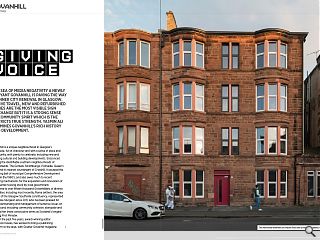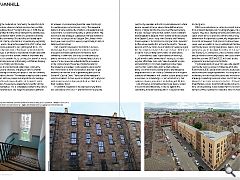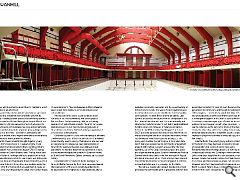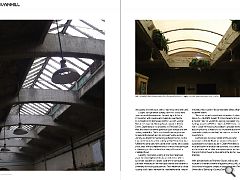Govanhill: Giving Voice
30 Apr 2024
In a sea of media negativity, a newly buoyant Govanhill is paving the way to inner-city renewal in Glasgow. Active travel routes and new homes are the most visible signs of change but a strong sense of community spirit is the district's true strength. Yasmin Ali examines Govanhill’s rich history and development.
Govanhill is a unique neighbourhood in Glasgow’s Southside, full of character and with a sense of place and community, with plenty to celebrate, including new and ongoing cultural and building developments. Ensconced among the identifiable southern neighbourhoods of Pollokshields, The Gorbals, Strathbungo, Polmadie, Queen’s Park and its nearest counterpart of Crosshill, it escaped the wrecking ball of municipal Comprehensive Development Areas in the 1960’s, and also owes much to recent planning mechanisms for the acquisition and renovation of tenemental housing stock by local government.
Home to over fifteen thousand Govanhillians of diverse ethnicities, including most recently, Roma settlers, the area is part of the Glasgow Southside constituency, represented by Nicola Sturgeon since 2011, who has been praised for her understanding and management of sensitive issues on the ground, including community cohesion, alongside and beyond her three consecutive terms as Scotland’s longest-serving First Minister.
For the past five years, award-winning editor Rhiannon Davies, has worked to bring a publishing platform to the area, with Greater Govanhill magazine offering the multicultural community the opportunity to communicate, shape and affect positive change within their neighbourhood. Moving to the area in 2018, Davies had identified that the critical stories in the tabloid press were not representative of the civic pride and diversity within the community. She identifies and builds upon Govanhill’s history of activism and community organising - in her words, the area has a quiet kind-of-DIY ethos, and a grassroots approach to ‘just getting stuff done’.
The community newsroom of the magazine she launched in 2020 plugs-in perfectly to that shared mindset and is the cultural capital of the resident writers it empowers and employs. It is a public-facing participative space for events that promote inclusion and learning and that are shaping local social history and discourse. There are myriad social enterprises, community organisations, charities, and groups within Govanhill with inspiring community-led projects that are creatively regenerating the area. The magazine was founded to shine a light on all these people and projects to acknowledge that problematic issues do exist, but to report them in a solutions-focused way, researched and written by the locals themselves.
This is completely counter to the culture of mainstream medi. Our magazine provides a platform for unheard voices and recognises the value that brings to creating a more cohesive community. The magazine helps its diverse community of writers and readership look outward and not revert to insularity or ethnocentrism. The love of print and analogue publication methods extends to other local ventures such as Glasgow Zine Library, which hosts year-round events as well as programming its annual Glasgow Zine Festival. Part of a print renaissance movement in our post-internet age, there’s unmistakable value in the printed magazine.
It enables community members to have something in their hand that they can then physically give to someone and that act of sharing helps to build a sense of pride, as well as authenticate the provenance of the stories shared. The sense of pride fostered by the magazine encouraged local people to care more for the environment to want it to be better and want to get involved, for example, in an organised big litter pick for Govanhill’s Spring Clean. This is part of the magazine’s extended mission: to have a positive impact on the physical environment as well as how people think and feel about their neighbourhood. In Govanhill, integration is happening in a way that is not even labelled as such, it is just intrinsic to the way the community operates, and acts as a societal leveller, where people see each other as equals. Govanhill has a long history of migration into the area. Over the past century, the area has been home to Irish, Jewish, Italian, Pakistani and Bangladeshi diaspora.
More recently joined by people from Eastern Europe, many from Slovakia and Romania. Davies explains it is described as Glasgow’s Ellis Island as it is often where people first arrive in the country. There are parallels with New York City as modelled on Glasgow’s grid, but the comparison is apt as the area has been the first port of call for many settling communities for generations. The smaller flat sizes, higher density of dwellings, together with public ownership of housing stock helps regulate affordable rents and makes Govanhill inclusive and welcoming, to incomers. Feeling at home, these communities tend to stay, and the area is cited as being one of the most culturally diverse and integrated neighbourhoods in the country. Govanhill has lots of great examples of integration with creative cultural projects and a resistance to ‘Artwashing’ – a form of art activity that catalyses urban regeneration thus fuelling gentrification – a lot of creative community projects are deeply rooted in Govanhill and attitudinally many are against this, considering inclusion and integration to be part of their founding aims. MILK is a social enterprise set up to support women from a migrant background, including refugees and asylum seekers.
They are a catering company and community space whose aim is to provide a safe and welcoming environment that promotes community integration within Govanhill and beyond. Their space is multifunctional, after seven years as a café it is now an established full-time community space hosting local groups, classes, workshops, and pop-up events. Amongst its notable pilot projects is Our Rights, Our Communities, which aimed to deliver a unique model of community-based, New Scots Women-led advocacy over 2021 and 2022, with partnership organisations including Govanhill Baths. The People’s Bank of Govanhill was a site-specific community currency project initiated by artist Ailie Rutherford in 2015, based on the idea of a local pound and currency exchange experiments, including ad-hoc exchanges, on-the-street discussions and workshops mapping intersecting local economies. Out of that came interest in the circular economy in the form of Govanhill Swap Market, a swap-shop for both goods and services like time banking trading. It also created Feminist Exchange Network (FEN), a women-led collective based in South Glasgow, which pushes for alternatives to capitalism, which originated in an art project.
It seems that protests and activism have programmed resilience and resistance into Govanhill’s genome. Its projects – relating to built spaces and community activity – have survived and thrived through and beyond Brexit and the pandemic. Art also serves as a form of advocacy for communities to communicate creatively and authentically. Its communities meet in local spaces, propagating creative activity in all its forms – transient or permanent, site specific or mobile, with a regenerative effect on the area to its betterment, even between lockdowns. The We Create Govanhill brought together young people from local schools to create an original mural about what their area means to them, working with arts organisations Vox Liminis and Glasgow CREATE during the easement of Covid-19 restrictions.
The Big Noise Yard Build in Govanhill, a design and build project for the local music education project of the same name was featured in a previous issue of Urban Realm. It was initiated by a group of Glasgow School of Art architecture students under the banner of In The Making which allowed them to make up for lost time when the pandemic called a halt to their hopes of work placement. They produced an outdoor rehearsal space in just three weeks, to serve and include local schoolchildren. Arts education for school pupils continues to be nurtured in the local community, with active project Rumpus Room that empowering children and young people on art and activism projects. The artist-run young people’s project co-run their Studio Langside Lane in Govanhill as a local base that hosts a lively programme of art and social action projects. Govanhill is spoilt for choice with the variety of different creative projects, a lot of them social history in the making.
Simon Murphy, award-winning Photographer and Lecturer at Glasgow Kelvin College, has been taking photos of Govanhill for over twenty years, specialising in street portraiture. He has also documented a portrait of a place, and his recent retrospective exhibition ‘Govanhill’ hosted at Street Level Photoworks Gallery, serves as part of social history. Govanhill’s fabric includes its Baths, managed by Govanhill Baths Community Trust, who have spearheaded the regeneration of the much-loved Edwardian Baths. Its restoration to its original use is well underway, after a sustained community campaign, and the recent backing of 500k of council funds. This was to help mitigate increases in construction costs due to a multitude of unforeseeable contingencies, not least Brexit and the pandemic. Last summer it reached a milestone with the completion of the first phase of the refurbishment. It is now externally and structurally ready for interior fit-out, but it needs additional funds to cover cost increases in materials and labour, further to the 500k provided by Glasgow City Council.
GBCT is chaired by local artist and activist, Alex Wilde. As well as chairing the board for the bath’s renovation, Wilde has developed several participatory art projects over many years to utilise the bath’s space in its interim state. GBCT manages several creative community engagement projects with multiple outreach groups within the area, operating out of The Deep End multipurpose arts space, and organises the inaugural Govanhill International Festival Carnival which takes place in the first fortnight of August and has an anti-racist ethos. These activities have spurred the community to remain active and engaged in both the outreach activities and the campaign for the Baths.
The baths, a regeneration project founded on protest, embodies the community spirit of grassroots activism that personifies Govanhill. For over 20 years the project has galvanised the community, and though its restoration is still in progress, I could not have predicted, when I visited and photographed its dereliction fifteen years ago, that it would garner support in the order of several million for its restoration and reimagining as a Turkish baths and wellness centre. However, as with other onlookers, I could see the potential; as the panoramic photo of the main baths shows, the distinctive red trussed ceiling, handsomely demonstrating structure as ornament, above a large pool of impressive proportions in which it would be a joy to swim a few lengths.
Like the Baths, the cycle highway and local stretch of The South City Way, has been an ongoing process of consultation and construction for many years. Residents have mixed feelings about it: as with any new infrastructure, and as with Edinburgh’s new tramlines in Leith, some local people feel it is a bit dangerous in places because people may wander across it without realising its purpose, and there are places where cars cut across it. However, now that it has been built, it is generally accepted that it is a good thing to have a cycle path that goes from Govanhill in to town, not least as the area is not served by the subway, and the cycle path is reportedly very well used. Despite its high urban density, new infill blocks have been successfully woven into the existing built fabric of Govanhill, with massing and materials specified to be sympathetic to townscape context, as with George Buchanan’s apposite Housing Development at Allison Street. Capitalising on its proximity to The South City Way, the estate combines generous cycle storage and low parking availability. The homes benefit from a generous communal backcourt serving as a community garden.
Density is a driver for maintaining sufficient homes for the area, and a standalone block designed by DO-architecture, fulfilled this atypically with a bold seven-storey deck access block, sited with a companion block of more modest height and massing on the northern boundary of Govanhill at Inglefield Road. Recently renovated existing properties have been given the same high level of care and attention, which was made possible on a grand scale by the compulsory purchase measures of the municipal council and transfer of ownership to housing associations. Their retention as social housing stock helps maintain the reasonable rental rates of the area, which sustains its communities without flight due to gentrification. The sensitive and considered restoration of a decayed Grade A-Listed 1876 ‘Greek’ Thomson tenement to provide 8 modern flats for Govanhill Housing Association, by skilled heritage experts ASSIST architects in 2020 had a crucial role in Govanhill Housing Association’s programme to acquire property to help reverse a rundown area of multiple deprivation, with partnership from national and local government. Furthermore, the deep retrofit of the pre-WWI tenement on Niddrie Road to maximum Passivhaus sustainability standards by John Gilbert Architects is a local precedent in an area that continues to celebrate pride and architectural excellence in innovative restoration of the local historic housing, thus setting the bar for new best practice.
With special thanks to Rhiannon Davies, editor, and founder of Greater Govanhill magazine (since 2019), and Groundswell magazine project in association with The University of Edinburgh (Spring/Summer 2023).
|
|






